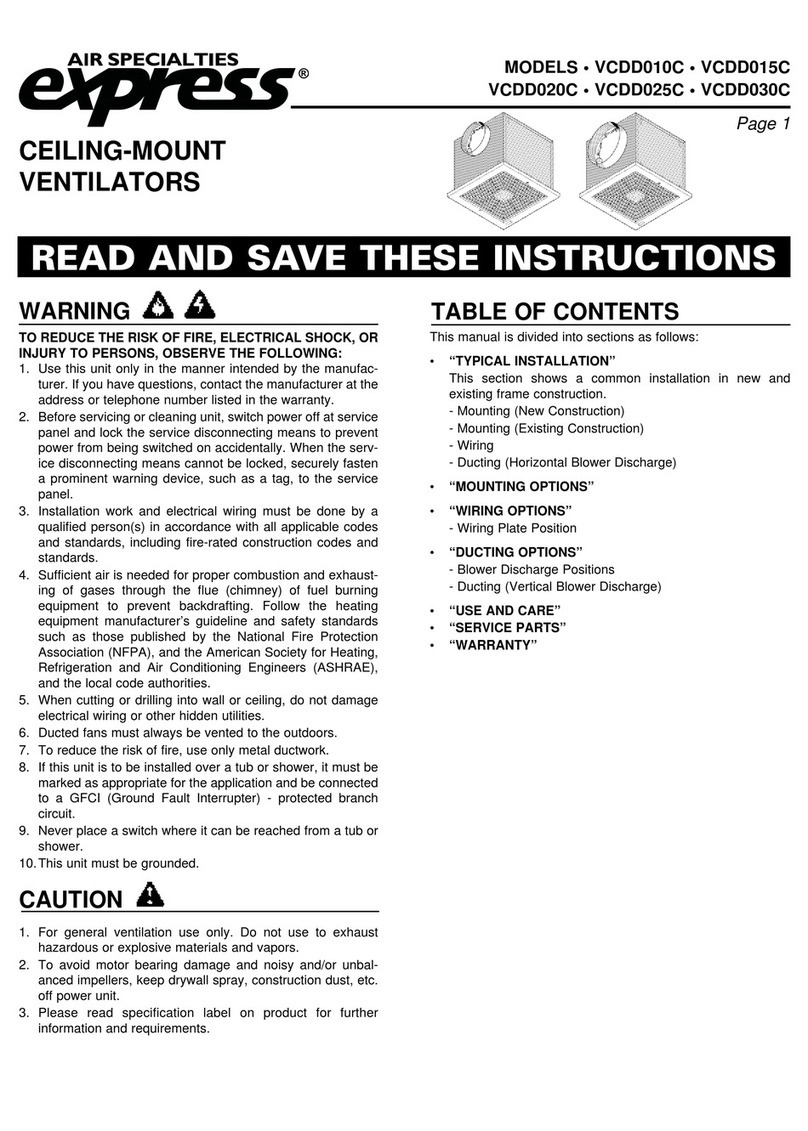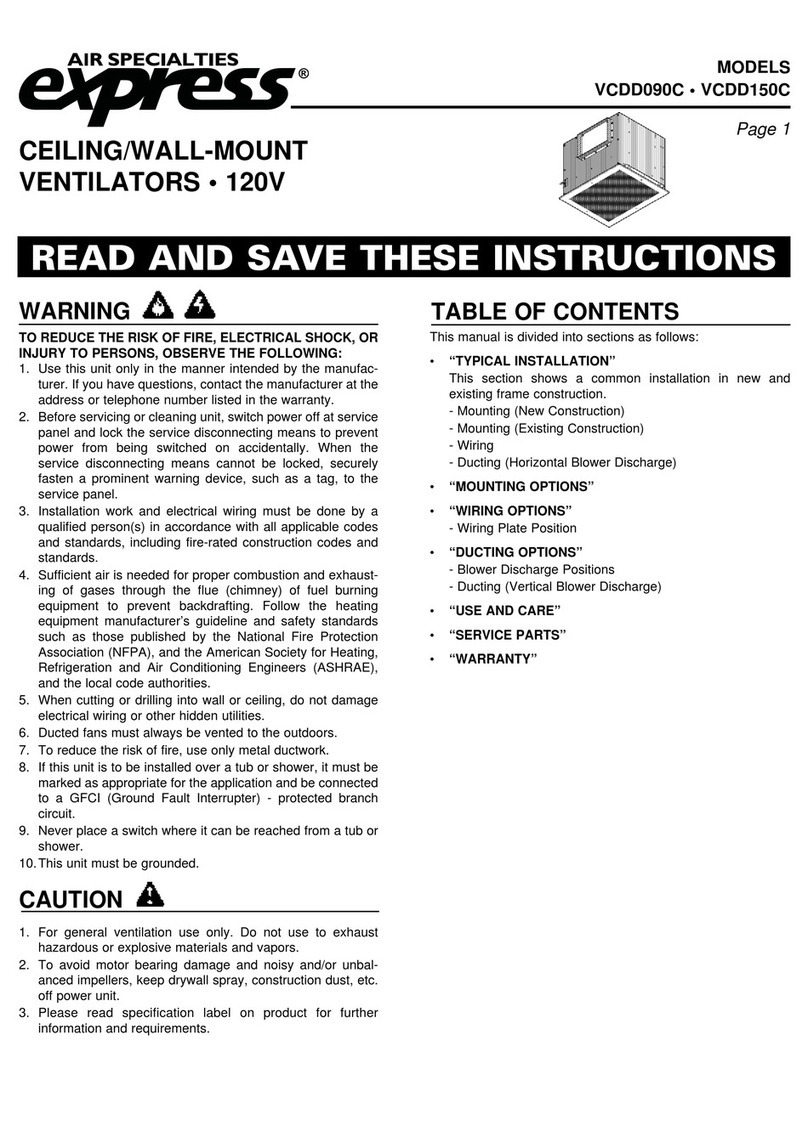5
MODEL VEBK - BELT DRIVE - PARTS LIST
STANDARD
Motor Cover Pillow 7Diffusers 9
Motor 4Vibration 5Block (Set of 4) / Wind 11
Unit Fan 3Mount Isolator Fan 6Bearings Fan 8Support Std. 10 Band Curb 12
Size LID 1Tube 2Shroud Assem’y (4 Req’d)* Shaft (2 Req’d) Plate Frame Wheel (Pieces) Cap
06 384-6521 384-6172 384-6131 384-0661 998-6126 998-5421 999-8606 384-6101 384-2451 384-0544 - - 384-2401
08 384-6521 384-6172 384-6131 384-0661 998-6126 998-5421 999-8606 384-6101 384-2452 384-0548 - - 384-2401
10 384-6521 384-6172 384-6132 384-0661 998-6126 998-5421 999-8606 384-6102 384-2453 384-0552 - - 384-2402
12 384-6521 384-6172 384-6132 384-0661 998-6126 998-5421 999-8606 384-6102 384-2454 384-0555 - - 384-2402
15 384-6522 384-6175 384-6133 384-0663 998-6126 998-5421 999-8606 384-6103 384-2455 384-0559 - - 384-2403
18 384-6523 384-6178 384-6134 384-0665 998-9748 998-5421 999-8606 384-6104 384-2456 384-0563 - - 384-2404
21 384-6524 384-6180 384-6135 384-0667 999-9748 998-5423 999-8637 384-6105 384-2457 384-0565 - - 384-2405
24 384-6525 384-6182 384-6136 384-0669 999-9748 998-5423 999-8637 384-6106 384-2458 384-0566 - - 384-2406
30 384-6526 384-6201 384-6137 384-0646 999-9748 998-5435 999-8632 384-6111 384-0521 384-0636 (2) 384-2591 384-2421
36 384-6527 384-6203 384-6138 384-0648 999-9748 998-5427 999-8633 384-6112 384-0522 384-0637 (2) 384-2592 384-2423
42 384-6528 384-6205 384-6139 384-0651 999-9748 998-5429 999-8634 384-6121 384-0526 384-0638 (2) 384-2593 384-2431
48 384-6528 384-6205 384-6140 384-0651 999-9748 998-5429 999-8634 384-6122 384-0527 384-0639 (2) 384-2594 384-2433
54 384-6528 384-6205 384-6141 384-0651 999-9748 998-5431 999-8634 384-6123 384-0531 384-0640 (2) 384-2595 384-2435
Unit
Size Volt
Code Motor
Type Unit Construction
Standard Extended
06-18
A,B,D
11/2 HP & Lower 3/4 HP & Higher
21/4 HP & Lower 1/3 HP & Higher
51/3 HP & Lower 1/2 HP & Higher
6ALL
C,E,G,H 1,5,8,9 3/4 HP & Lower 1 HP & Higher
2,6,7 ALL
21-24
A,B,D 1,2,5,6 ALL
C,E,G,H 1,5,7,8,9 5 HP & Lower 7-1/2 HP & Higher
2,6 2 HP & Lower 3 HP & Higher
30-54
A,B,D 1,2,5,6 ALL
C,E,G,H 1,5,7,8,9 5 HP & Lower 7-1/2 HP & Higher
2,6 2 HP & Lower 3 HP & Higher
Motor Type Volt Code
1 = ODP A = 115 1ø
2 = 2 Spd. 2 Winding B = 208 1ø
5 = TE C = 208 3ø
6 = Exp. Proof D = 230 1ø
7 = 2 Spd. 1 Winding E = 230 3ø
8 = ODP High Eff. G = 460 3ø
9 = TE High Eff. H = 575 3ø
EXTENDED
Motor Cover Pillow 7Diffusers 9
Motor 4Vibration 5Block (Set of 4) / Wind 11
Unit Fan 3Mount Isolator Fan 6Bearings Fan 8Support Std. 10 Band Curb 12
Size LID 1Tube 2Shroud Assem’y (4 Req’d)* Shaft (2 Req’d) Plate Frame Wheel (Pieces) Cap
06 384-6521 384-6173 384-6131 384-0662 998-6126 998-5422 999-8606 384-6101 384-2451 384-0544 - - 384-2401
08 384-6521 384-6173 384-6131 384-0662 998-6126 998-5422 999-8606 384-6101 384-2452 384-0548 - - 384-2401
10 384-6521 384-6173 384-6132 384-0662 998-6126 998-5422 999-8606 384-6102 384-2453 384-0552 - - 384-2402
12 384-6521 384-6173 384-6132 384-0662 998-6126 998-5422 999-8606 384-6102 384-2454 384-0555 - - 384-2402
15 384-6522 384-6176 384-6133 384-0664 998-6126 998-5422 999-8606 384-6103 384-2455 384-0559 - - 384-2403
18 384-6523 384-6179 384-6134 384-0666 998-9748 998-5422 999-8606 384-6104 384-2456 384-0563 - - 384-2404
21 384-6524 384-6181 384-6135 384-0668 999-9748 998-5424 999-8637 384-6105 384-2457 384-0565 - - 384-2405
24 384-6525 384-6183 384-6136 384-0670 999-9748 998-5424 999-8637 384-6106 384-2458 384-0566 - - 384-2406
30 384-6526 384-6202 384-6137 384-0647 999-9748 998-5426 999-8632 384-6111 384-0521 384-0636 (2) 384-2591 384-2421
36 384-6527 384-6204 384-6138 384-0649 999-9748 998-5428 999-8633 384-6112 384-0522 384-0637 (2) 384-2592 384-2423
42 384-6528 384-6206 384-6139 384-0652 999-9748 998-5430 999-8634 384-6121 384-0526 384-0638 (2) 384-2593 384-2431
48 384-6528 384-6206 384-6140 384-0652 999-9748 998-5430 999-8634 384-6122 384-0527 384-0639 (2) 384-2594 384-2433
54 384-6528 384-6206 384-6141 384-0652 999-9748 998-5432 999-8634 384-6123 384-0531 384-0640 (2) 384-2595 384-2435
*Sizes 42, 48, 54 get (5) Vibration Isolators.



























